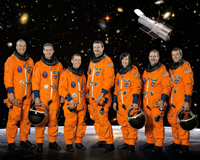Hubble Revitalised
Service Mission Observatory Verification
 |
|
The crew of STS 125 who carried out SM4. Credit: NASA |
However Hubble is not yet ready for science, rather we are at the beginning of a detailed and thorough commissioning phase termed Servicing Mission Observatory Verification (SMOV) which will last for approximately four months. This phase is led by STScI and involves a detailed assessment of Hubble to ensure that the telescope, its instruments, and infrastructure are indeed working to specifications and are fit for scientific purpose.
During SMOV a complex and comprehensive range of tasks is performed ranging from monitoring the thermal environment of the telescope to extremely detailed analysis of calibration data. Each instrument and sub-system has a pre-planned sequence of activities tailored to the commissioning requirements of the instrument in question. Each activity is led by a scientist or engineer at STScI or GSFC, and coordinated by the instrument Team Lead or Technical Lead at STScI.
As an example, a typical sequence of SMOV activities for the Space Telescope Imaging Spectrograph (STIS) would include engineering tests (mechanism, calibration lamp, electronics and aperture wheel), alignment and focus checks, and then for each detector (STIS has three; a CCD, a far-UV MAMA and a near-UV MAMA) a series of tests of the detector properties, optical format, image quality and throughput.
The SMOV programme will be completed in 16 weeks. As each activity is completed, the results are transferred to STScI for verification. Data are archived, processed and are made available to the analysis teams at STScI for immediate investigation. SMOV meetings are held each morning to review progress and discuss issues or potential problems based on input from the analysis teams from the previous day. As we move through SMOV we subject each instrument on Hubble to an exhaustive health check prior to giving it the green light for science, and re-establishing Hubble as the foremost observatory at our disposal.
Written by:
Antonella Nota and Danny Lennon
Space Telescope Science Institute, Baltimore, USA
2 June 2009
